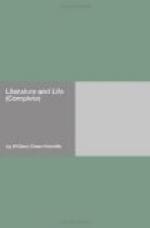It must be owned that we have no longer anything so like a ‘salon’ as this. It is, indeed, rather terrible, and it is of a quality in its celebrities which may well carry dismay to any among us presently intending immortality. Shall we, one day, we who are now in the rich and full enjoyment of our far-reaching fame, affect the imagination of posterity as these phantoms of the past affect ours? Shall we, too, appear in some pale limbo of unimportance as thin and faded as “John Inman, the getter-up of innumerable things for the annuals and magazines,” or as Dr. Rufus Griswold, supposed for picturesque purposes to be “stalking about with an immense quarto volume under his arm . . . an early copy of his forthcoming ‘Female Poets of America’”; or as Lewis Gaylord Clark, the “sunnyfaced, smiling” editor of the Knickerbocker Magazine, “who don’t look as if the Ink-Fiend had ever heard of him,” as he stands up to dance a polka with “a demure lady who has evidently spilled the inkstand over her dress”; or as “the stately Mrs. Seba Smith, bending aristocratically over the centre-table, and talking in a bright, cold, steady stream, like an antique fountain by moonlight”; or as “the spiritual and dainty Fanny Osgood, clapping her hands and crowing like a baby,” where she sits “nestled under a shawl of heraldic devices, like a bird escaped from its cage”; or as Margaret Fuller, “her large, gray eyes Tamping inspiration, and her thin, quivering lip prophesying like a Pythoness”?
I hope not; I earnestly hope not. Whatever I said at the outset, affirming the persistent equality of New York characteristics and circumstances, I wish to take back at this point; and I wish to warn malign foreign observers, of the sort who have so often refused to see us as we see ourselves, that they must not expect to find us now grouped in the taste of 1849. Possibly it was not so much the taste of 1849 as the author of ‘New York in Slices’ would have us believe; and perhaps any one who trusted his pictures of life among us otherwise would be deceived by a parity of the spirit in which they are portrayed with that of our modern “society journalism.”




